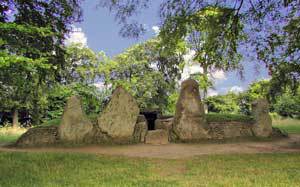Wayland's Smithy
Wayland's Smithy is one of the most impressive and atmospheric Neolithic burial chambers in Britain. Somehow this ancient grave became associated with Wayland, the Saxon god of metalworking, from whom it takes its name.
The burial chamber underwent two distinct phases of construction, identified during excavations in the 1960's. In the first phase an oval mound was erected, which covered a wooden and stone structure with a floor paved with Sarcen stones. The remains of 14 bodies were found from this period, all badly damaged as if the roof had fallen in on them. No part of this structure now survives, as it was incorporated into the mound seen today.
In Phase 2, started around 3500BC, the mound was enlarged to a trapezoid shape using earth from two flanking ditches which are no longer visible. The mound was edged with Sarcen slabs, and had a facade of 6 larger stones (two of which are missing) at the Southern end. A stone lined passage was built within this Southern face with two chambers forming a cruciform shape. When excavated the bones of 8 people were found, although the tomb had been robbed long before, probably during the Iron Age period.
Traditionally, Wayland inhabited the mound and was ready to shoe a horse. The horse had to be left at the mound alone for a short period, along with the payment of a silver coin. On returning the horse would have been shod and the payment would have disappeared.
Wayland’s Smithy is located just off the Ridgeway path, approximately 1½ miles west of The Uffington White Horse. Entry is free. The easy walk from the White Horse provides lovely views over the Berkshire Downs to the south and over the Vale of White Horse to the north. It is possible to drive to a point closer to Wayland’s (turn up the hill from the Knighton junction on the B4507) but parking is limited to a small lay-by large enough for only a few cars. There are no visitor facilities.







